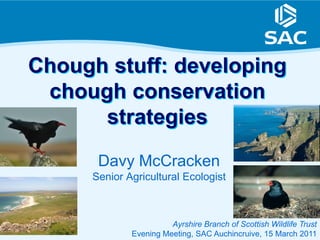McCracken SWT presentation
- 1. Chough stuff: developing chough conservation strategies Davy McCracken Senior Agricultural Ecologist Ayrshire Branch of Scottish Wildlife Trust Evening Meeting, SAC Auchincruive, 15 March 2011
- 2. Chough stuff: developing chough conservation strategies Scottish Chough Study Group Eric, Sue & Caitlin Bignal Pat Monaghan & Maria Bogdanova Jane Reid
- 5. Islay: mixture of land types Land types on Islay A: Upland heath, moorland and bog H: Coastal sedge B: Rocky coastal grassland and moorland, heath permanent pasture and grassland G: Sandy coastal C: Broken moorland ISLAY rushy fields and rough pasture and machair pasture F: Small farms and D: Blanket bogs, crofts and moorland lowland moorland edge and rough pasture E: Rotational pastures and mixed farmland mosaics
- 6. Islay: variety of bird species
- 7. Islay: variety of bird species Annex 1 birds on Islay LAND-TYPE A B C D E F G H W-Fronted Goose Golden Eagle Barnacle Goose Hen Harrier Corncrake Merlin Peregrine Red-Throated Diver Golden Plover Chough NESTING SUMMER WINTER
- 8. Chough on Islay: annual no. of breeding pairs 90 Number of breeding pairs 80 70 60 50 40 30 20 1980 1985 1990 1995 2000 2005 8
- 9. Detailed understanding through, e.g., students and Earthwatch 9
- 10. Colour-ringing has been crucial for detailed understanding
- 11. Colour-ringing has been crucial for detailed understanding
- 12. Chough annual cycle 12
- 13. Major factors affecting chough on Islay (1) Nest site availability (2) ‘Suitable’ feeding areas 13
- 14. Chough on Islay: increase in 1980s 90 Number of breeding pairs 80 70 60 50 40 30 20 1980 1985 1990 1995 2000 2005 14
- 15. Provision of nest sites in good feeding areas 15
- 16. Chough diet on Islay Chough Diet on Islay J F M A M J J A S O N D SOIL Tipulidae Bibionidae Lepidoptera larvae DUNG Diptera larvae Coleptera adults Coleoptera larvae SURFACE-ACTIVE VEG Cereals Gagea 16
- 17. Dung insects important LIVESTOCK DUNG •Waves of invasion •Diptera (flies) •Coleoptera (beetles) •Nematodes & mites •Earthworms & soil inverts •Valuable resource IMPACT OF AVERMECTINS •Invertebrates in dung •Knock-on effects •Invertebrate communities? • Chough & other birds? 17
- 18. Dung insects important DAMAGE LIMITATION STRATEGY •Livestock need treatment •Assess potential/real risk •What is being used? •When and how often is treatment applied? •Ecology of wildlife of concern? •Manipulate •Method of application of treatment? •Timing of treatments? •Dung invertebrates need dung!! 18
- 19. Leatherjackets in grassland: annual mean number per field
- 20. Chough on Islay: annual no. of breeding pairs Assessed by full 90 census Number of breeding pairs 80 Predicted from population 70 dynamics model 60 50 40 30 20 1980 1985 1990 1995 2000 2005
- 21. Major factors affecting chough on Islay (3) Bottlenecks to recruitment - high nestling mortality - post-fledging survival 21
- 22. Focus on post-fledging survival • Observe the colour-ringed choughs • Follow their movements • Collect data on their feeding habits 22
- 23. Focus on post-fledging survival Movement from nest sites to sub- adult flock areas Map removed from slide before making presentation more widely available 23
- 24. Focus on post-fledging survival Highlighted importance of sand dune systems - 90% of foraging observations between April 06 and March 08 24
- 25. Focus on post-fledging survival Silage aftermaths also important - 10% of observations between June 06 and August 08 (but concentrated in June – August period) 25
- 26. Focus on post-fledging survival More diverse sward and structure Increased forb and seed resource Increased invertebrate resource Increased soil accessibility 26
- 27. Chough on Islay: annual first year survival probability Marked differences in survival since 2007 – last four years, i.e. including 2010 cohort, has been c. 10% or less
- 28. Chough on Islay: annual first year survival probability Major differences in July – September period in 2007- 2010. Large proportion of mortality occurring during that period
- 29. Chough on Islay: annual first year survival probability First year survival probability of each years young: Solid line = based on re-sightings of colour-ringed birds post-fledging Not simply a Dashed line = predictions based on weather and leatherjacket abundance food abundance issue. Predictions not reflecting reality since 2007– could grassland grazing &/or cutting regimes be preventing access to insect prey at key times?
- 30. What does the future hold? 30
- 31. Further information Refereed papers: 6 in Journal of Animal Ecology and 1 in Journal of Applied Ecology to-date Chough – the story http://efncp.org/hnv-showcases/scottish-hebrides/chough/facts/ Developing conservation strategies for the chough in Scotland http://www.knowledgescotland.org/briefings.php?id=148 British Wildlife, 1997, vol. 8, issue 6, pages 373-383 31
- 32. 32
































